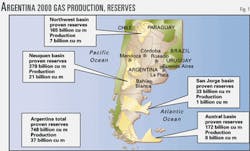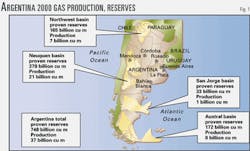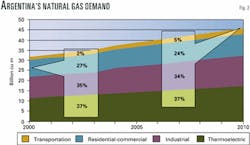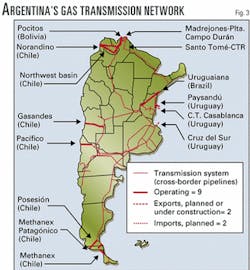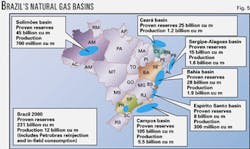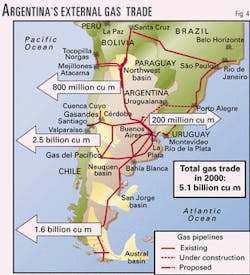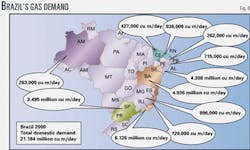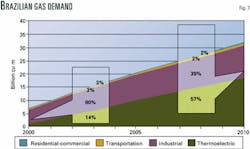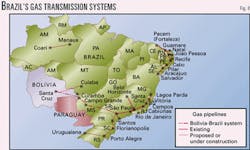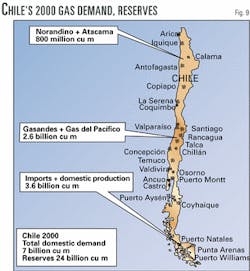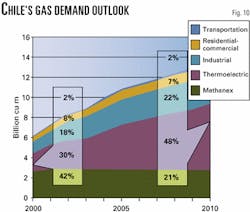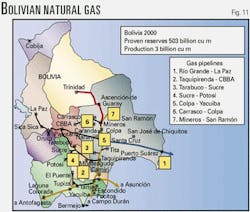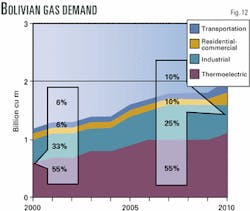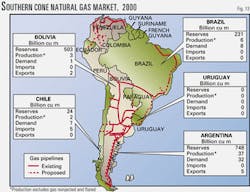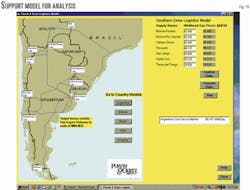Gas & Power in Latin America: South America's Southern Cone gas, power sectors taking first steps toward energy integration
Since the privatization of Argentina's energy sector beginning in 1992, South America's Southern Cone has under- gone dramatic changes in natural gas and power markets.
Most notable are the first steps toward an integration of the gas and power markets in the region.
The impact of privatization on Argentina's natural gas market, already the most mature in the region, was to spur a major increase in domestic demand while also transforming the sector into a true export hub for natural gas, LPG, and electricity.
The increase in domestic gas consumption results mainly from the increase in gas-fired power capacity with the installation of a number of new combined-cycle cogeneration power plants, the use of natural gas for industrial and petrochemical consumption (aluminum, urea, LPG), and the further development of a vehicular compressed natural gas (CNG) market.
At the same time, Argentina's energy exports have grown notably as a consequence of a regional foreign market short of power and gas resources. Growing export markets have spurred the construction of gas pipelines to Chile, Brazil, and Uruguay and required the expansion of transportation infrastructure and power interconnections with these neighboring countries.
Several other players, motivated by regional integration, are also defining new roles in this emerging market:
- Bolivia, where enormous reserves of natural gas have been discovered that are excess to current market needs.
- Chile, which is an energy importer with an infrastructure of gas pipelines capable of satisfying future import needs and which has very flexible regulations.
- Brazil, which is the greatest consumer of energy in the region but is still in the process of establishing local regulations.
- Uruguay, which has a small market but a strategic location from which to reach Brazilian territory.
These are different countries with different needs but all favored by the ability to complement each other's needs. This will allow them to consolidate future strong energy ties in the region.
Argentina overview
Argentina has 750 billion cu m (bcm) of proven natural gas reserves, the second biggest in Latin America. Last year, production reached a volume of 45 bcm, thus covering the supply needed for the next 17 years. Argentina has four main producing basins: Northwest, Neuquen, Gulf of San Jorge, and Austral (Fig. 1). The prospects for growth in natural gas domestic demand and exports will force Argentina to commit to major exploration and development. The main producers are Repsol-YPF SA, with a 44% share, followed by Panamerican Energy LLC, TotalFinaElf SA, Perez Companc SA, and Pluspetrol SA.
In 2000, demand totaled 37 bcm (32 bcm domestic, 5 bcm exports), representing an increase of more than 100% over the consumption levels of 1990. The greatest share of Argentine consumption growth is accounted for by the new gas-fired cogeneration power plants, followed by expansion in petrochemicals-notably at the Bahia Blanca complex, expansion of aluminum plants, greater production of urea, increased LPG fuel usage in gas processing plants, growth in residential demand, important growth in the CNG market, and strong growth in exports, mainly to Chile, followed by Brazil and Uruguay (Fig. 2).
In a realistic scenario, it is expected that Argentina's domestic consumption will reach 45 bcm, and exports will rise to 17 bcm to Chile, Brazil, and Uruguay, for an increase of 70% from the current consumption level.
The Argentine power system has also grown considerably as a consequence of the construction of new combined-cycle plants. Currently, the total power capacity installed is 22,000 Mw, of which 11,000 Mw are cogeneration plants, with a ratio of installed capacity to peak demand of 1.5:1. Thus, Argentina can satisfy domestic demand and, depending on demand evolution, might be able to export power.
To adequately achieve this goal, Argentina will have to improve its transmission network, as well as to implement all projects proposed in the government's Federal Plan. The transmission system is divided in two major subsystems: SADI and the Patagonic System, representing 93% and 6% of the total, respectively. The interconnections proposed in the Federal Plan consist of connecting both systems (Patagonic Interconnection) and the Northeast with the Northwest, so that power plants located in the Northeast can supply Brazil. The Comahue-Cuyo plant, with future expansions, could reach the Chilean market, and the Mining interconnection could link the west-central region of the country with the Northwest. There are already in place power export agreements with Brazil for about 3,000 Mw, and a cogeneration power plant has been built (Termoandes, 640 Mw) and interconnected with the Chilean trans- mission system.
The gas transportation system in Argentina operates under a strong seasonal demand produced by significant residential consumption. The system exhibits a balanced use of its current capacity, which will need to be increased in the future to satisfy growing demand.
Development of the current export transportation system requires only the completion of the Cruz del Sur gas pipeline to Uruguay and the MGT (Mercosur Gas Transport) connection from Uruguayana to Porto Alegre in Brazil (Fig. 3). Repsol-YPF is currently discussing with Petroleo Brasileiro SA the possible large-scale export of Neu- quen basin gas to Brazil, through Uruguayana and involving as much as 20 million cu m/day (7.3 bcm/year) needed to supply new cogeneration power plants. To be fully successful, this project will require a 75% increase in gas production in the Loma la Lata (Neuquen) area, as well as contributions by other producers, such as Perez Companc, Chevron Corp., and Pioneer Natural Resources Inc. It also will require the implementation of an expansion program for the gas pipelines of the North Gas Transportation (TGN) system, whose main owners are TotalFinaElf, Techint SA, Cia. General de Combustibles, and Malaysia's Petronas.
At the retail level, Argentina's domestic natural gas distribution system has nine distributors covering over 50% of Argentine households; the remainder of the residential gas de- mand in Argentina is met by LPG. The highest concentration of residential gas demand (33%) is divided by two local distribution companies serving Buenos Aires and the surrounding area.
Argentina regulations
Currently, the Argentine distribution and transportation systems are facing their second 5-year tariff review since their privatization. The new tariff table will be in force in January 2003.
Argentina's gas regulatory agency Enargas, together with the distribution and transportation companies, will establish a joint task force. Its aim will be to obtain a more transparent and competitive system, without undermining the important goals achieved dur- ing the first decade of its existence. A detailed analysis is currently being carried out, as well as an evaluation of the impact of different policies and international experiences that could fit the local and regional markets.
The gas market is currently composed of five participants with different scopes, rights, and responsibilities: producers (private concessions, under the scope of the Department of Energy, with free-market pricing), transporters (private concessions whose sole activity is the transportation of gas through the existing systems, under the scope of Enargas), distributors (private and regional concessions whose responsibility is to distribute the gas), traders (controlled by Enargas and offering gas and transportation or gas resale services), and clients (residential, industrial, etc.).
The distinctive characteristics of this system include open access for transportation, the opportunity for implementing geographical and commercial distribution bypasses, and dominant vertical integration restrictions.
Producers are studying these conditions and are analyzing different projects that would help them maximize their profits through additional exports of natural gas and development of gas-to-liquids or LNG projects.
Political issues aside, the Argentine energy market keeps growing on very solid ground. Regional energy needs require that the market sector participants must clearly identify their goals and direct all efforts to successfully achieve them.
The price structure for natural gas in Argentina is based on wellhead prices (different in each basin and inversely proportional to the distance to Buenos Aires), transport tariffs (firm vs. interruptible), and distribution tariffs. Distributors offer their clients full services (residential, commercial, indus- trial, and power), and clients can opt for a commercial or geographic bypass to get more competitive prices.
In 2000, the average gas price per basin was $0.90/MMbtu, $1.20/ MMbtu, and $1.40/MMbtu for the Austral, Northwest, and Neuquen basins, respectively, with an average city gate price in Buenos Aires of $1.90/ MMbtu (Fig. 5).
Brazil
The Brazilian gas market is in full evolutionary mode, with an unsatisfied energy demand and great potential for growth.
Brazil has about 231 bcm of proven gas reserves, an insufficient volume for a country of its dimension. The main gas basins are the Campos, Bahia, and Ceara (Fig. 4). In 2000, production reached 12 bcm, with a domestic consumption of only 8 bcm. Forecast demand growth will reach 30 bcm in 2010, with power plants playing a very important role.
In 1999, Brazil's state-owned Petrobras and partners built the BTB gas pipeline from Rio Grande, Bolivia, to Sao Paulo, with a capacity of 30 million cu m/day. Petrobras also successfully conducted exploration programs in Bolivia in an effort to eradicate Brazil's energy deficit.
Brazil's power system depends on an installed capacity of 63,000 Mw, 93.5% of which is generated by hydropower, and it currently has few gas-fired power plants. The ratio between peak demand vs. installed power is about 1:1.
Undoubtedly, Brazil faces a critical situation that is being exacerbated by its dependence on a hydropower supply dependent on climate variables. In view of this crisis, the Decade Plan established a growth target that will require a supply of 99,000 Mw in 10 years, including 16,000 Mw of gas-fired power plants, 19,000 Mw of hydro plants, and 2,500 Mw of coal and diesel-fired plants.
In 2011, the volume of gas required by new power plants in Brazil is projected at 16 bcm. If we include the expected growth to 15 bcm in industrial demand-twice current levels-in addition to residential demand growth, the total volume needed could easily reach 35 bcm. The current BTB gas pipeline has a maximum capacity of 10 bcm/year, and gas production in Brazil currently totals 12 bcm/year. It is easy to conclude, based on this data, that Brazil will be under enormous stress to satisfy its domestic gas demand in 2011.
Are there other alternatives for Brazil to successfully supply its gas market? As proven reserves are still insufficient, Brazil will have to invest in new exploration domestically and, at the same time, search for alternative supplies in neighboring countries. Bolivia, as a consequence of its extraordinary increase in re- serves and the presence of Petrobras as the owner of a significant part of them, as well as of the BTB gas pipeline, seems to be Bra- zil's natural supplier.
Argentina, in turn, could be replaced as Brazil's main gas import supplier, unless more proven reserves are discovered (a possibility currently being pursued by Repsol-YPF), which would result in competitive gas prices.
Currently, Argentina supplies Uruguayana (South Brazil) through the TGN gas pipeline. In the future, this line will be extended to Porto Alegre and is capacity expanded to 4.4 bcm/ year.
Current gas production and exploration projects in Brazil are mainly in the hands of Petrobras, even though new concessions have allowed new investors to come on the scene (Texaco Inc., Royal Dutch/Shell, ExxonMobil Corp., Repsol-YPF). Petrobras has a major share in the Brazilian gas transportation network, with open access regulated by ANP, Brazil's petroleum regulatory agency. Distribution concessions have been granted to private investors and is regulated by each state. In the medium term, there are very few possibilities for significant growth in Brazilian gas production or supply infrastructure.
Chile
The Chilean market differs significantly from those of Argentina and Brazil.
Chile does, however, share with Brazil a lack of reserves (24 bcm), and the country has production of only 2 bcm/year, in the southern part of the country. As a consequence, an aggressive investment plan for the con- struction of gas pipelines has been implemented in collaboration with Argentina. This plan allows Argentine gas to be transported into and across the Chilean territory.
Nowadays, Chile has six gas pipe- lines that run from north to south and have a maximum capacity as follows: Atacama (8.5 million cu m/day), Norandino (8 million cu m/day), Gasandes (11 million cu m/day), Gas del Pacifico (4 million cu m/day), the two Methanex pipelines (2 million cu m/day and 2.9 million cu m/day). Gasandes and Methanex are currently the two pipelines with the highest capacity utilization rate. Atacama was constructed to satisfy the needs of two cogeneration power plants, with a combined capacity of 740 Mw (consuming 0.75 bcm in 2001), while Norandino's goal is to supply gas to three plants with combined capacity of 870 Mw (0.87 bcm/year beginning in 2004). In both cases, the total to be consumed is a third of the maximum available capacity. A similar problem occurs with Gas del Pacifico.
The main demand focal points are located in central Chile-in the metropolitan areas of Region V, which is supplied with 2.3 bcm/year of Argen- tine gas from the Neuquen basin to meet residential, industrial, and power demand; and in southern Chile, which is supplied with 1.8 bcm/year of gas via the Methanex pipelines from Argentina's Austral basin, almost all of it dedicated to industrial requirements (Methanex's petrochemical plants). Total demand in Chile last year reached 8 bcm (64% industrial, 27% power, and 7% residential). The forecast for the year 2010 is 14 bcm, due to the new cogeneration power plants and a higher industrial demand, specifically the mining sector.
The Chilean power system is composed of four systems, two of which represent 99% of the country's installed power: the Central Interconnected System (SIC, Regions III to X) and the Great North Interconnected System (SINC, Regions I and II). The total demand for electric power in Chile currently is 36,000 Gw-hr/year in SIC and SINC, split 78% and 21%, respectively. Installed power capacity is 6,800 Mw in the SIC system and 2,600 Mw in the SINC system.
It is expected that, in coming years, Chilean installed power capacity will increase by 2,000 Mw, with the construction of new gas-fired power plants. In addition, the two major systems are to be interconnected in 2005. This power system interconnection could permit a better utilization of the capacity of the northern gas pipelines.
The natural gas industry in Chile currently lacks adequate regulations. Transpor- tation and distribution companies, established through concessions, are very restricted by the Antitrust Com- mission. The National Energy Commission is in charge of granting concessions and approving regulations, while the Power and Fuel Superintendent's office is responsible for compliance. The integration of Argentine natural gas imports permits buyers and sellers to fix their prices freely, under nondiscriminatory conditions. The transportation system is based on open access, and the distribution system is based on geographic or commercial bypasses. There are no exclusive rights by area, and vertical integration is permitted.
Bolivia
During the last 2 years, Bolivia has started to play a more important role as a producer and exporter of natural gas, a consequence of an increase in reserves in 2000 to a total of 500 bcm proven and 411 bcm probable. These reserves will allow Bolivia to cover its own necessities and to make up for future shortfalls in Brazil. The main producers in Bolivia with a significant share in these reserves, are Repsol-YPF, BG PLC, TotalFinaElf, Petrobras, and ExxonMobil.
Domestic demand for natural gas scarcely reaches 1.2 bcm/year, against production of 5.5 bcm/year. Bolivia's distribution system is composed of five distributors that supply a local market (residential, commercial, and industrial users) of only 0.45 bcm/year, while the demand from cogeneration power plants is 0.6 bcm/year.
As a consequence, the country has a huge surplus of gas to capitalize on through traditional exports and through the implementation of petrochemical, GTL, and LNG projects. An LNG export project targeting the US market is currently under negotiation, with the participation of Repsol-YPF, BG, BP PLC, ExxonMobil, TotalFinaElf, and state-owned companies Yacimien- tos Petroliferos Fiscales Bolivianos, and Empresa Nacional del Petroleo (Chile). The project consists of constructing a 30 million cu m/day liquefaction plant at Mejillones, Chile. The LNG would be transported via tanker to Baja Califor- nia, Mexico, where it would be carried into the US through a gas pipeline.
The gas transportation system in Bolivia consists of a domestic gas pipeline network operated by Transredes (owned by Enron Corp., Shell, and the state pension funds) and export gas pipelines such as Rio Grande-Yacuiba (which extends to Argentina and is owned by Transredes) and the Rio Grande-Puerto Suarez (GTB) and San Miguel-Cuiabá (also owned by Transredes) systems, both extending to Brazil.
The GTB gas pipeline is owned by Transredes, along with Petrobras, BG, El Paso Corp., and Broken Hill Billiton Pty. Ltd. Capacity of this pipeline is distributed among the producers according to their current respective reserves and production levels after the Petrobras capacity allocation of 7 million cu m/day.
GTB volumes currently being transported total 8.5 million cu m/day, which does not cover DOP require- ments. Petrobas plans to construct a gas pipeline that will permit the transportation to GTB of all the gas reserves that the Brazilian state firm shares with TotalFinaElf and Repsol-YPF. As an alternative, there is also the possibility of transporting this gas through the expansion of the Transredes gas pipeline (Rio Grande-Yacuiba).
The Bolivian power system has an installed capacity of 900 Mw, with 62% generated by gas-fired cogeneration power plants, and the remainder generated by hydro plants. The system consists of a transmission network called the Central Interconnected System.
Bolivia has a complex regulatory system. The Ministry of Hydrocarbons is responsible for the upstream policy formation and regulatory enforcement, while the Hydrocarbons Superinten- dent's office manages the downstream, where YPFB holds a significant market share with the rest in the hands of private investors.
Domestic natural gas prices are controlled, while exports enjoy free pricing. Access to the transportation system is been granted to private companies through concessions, with open access and no exclusive rights by area. The superintendent's office reserves the right to call for new concessions and operation of new gas pipelines. The distribution system was also made avail- able to private investors through concessions, with prior authorization from local affected governments, that feature exclusive rights by area, with the gas supplied by YPFB.
Uruguay
Uruguay has no domestic production of natural gas, and its gas demand, consisting only of very small volumes for industrial use, is currently supplied solely by an Argentine gas pipeline that terminates at Paysandú. The construction of a gas-fired power plant with capacity of 300 Mw is been planned at Casablanca. The prospects for supply to the Colonia-Montevideo corridor will be clearly identified after the construction of the Cruz del Sur gas pipeline, expected to be ready by early 2003. The forecast for gas demand for power in 2005 is 1.5-2.0 bcm, depending on the expansion of Central Batle or the construction of a new combined-cycle plant with 400 Mw capacity.
Installed power capacity in Uruguay is 2,100 Mw, with 74% generated by hydro plants, and the rest generated by fuel oil-fired cogeneration power plants.
Conclusions
Given the current scenario and the energy potential of the Southern Cone market, we can identify main suppliers such as Argentina and Bolivia as well as main importers such as Brazil, Chile, and Uruguay.
Data for reserves, production, and prices confirm the special characteristics of each of these countries.
Any decisions on future investments must acknowledge the different policies and ability for each country to adjust to the new resource base and market demand. Brazil and Chile have developed a gas supply infrastructure, and in both cases, except for the Gasandes and Methanex gas pipelines in Chile, they still have a market lacking gas supply due to the delay in the construction of gas-fired cogeneration power plants and in the conversion of industries still consuming other fuels. As a conse- quence, the Southern Cone's gas pipe- lines are underutilized. Ironically, and in spite of counting on adequate resources available for transportation, there is an important energy deficit, especially in Brazil, resulting from noncompetitive prices.
A logistical model is necessary to understand regional gas integration in the Southern Cone countries. This model permits an analysis of the existing as well as the future infrastructure of the regional gas pipeline system. Purvin & Gertz Inc.-Freyre & Asociados has developed a model that utilizes linear programming to simulate the transportation and distribution of gas from the producing basins to the demand centers. The model uses basin prices, transportation and distribution costs, and the existing infrastructure to identify system investment needs. To support the logistical model, there is a series of databases and support models for each one of the relevant areas. These models include demand projection models, supply capacities, alternate fuels, and storage effects (Fig. 13).
The logistical model can be used to reconfirm price differences between producing basins and to identify the flow of gas to be imported and exported. It can determine the consumption of alternate fuels (fuel oil, LPG, or distillates) and the percentage of utilization of the transportation network.
Future decisions to impact energy integration in the Southern Cone will require one to not only be well-acquainted with regional gas policies but also to fully understand the premises that will promote power and gas integration.
These premises, along with integral models such as the logistical model, will help define future investments and identify Southern Cone energy focal points.
In the long term, the Southern Cone energy market will develop greatly through integration programs and a ever-expanding network of gas pipe- lines and power transmission lines that will optimize the resources and will give flexibility to the system.
The authors
Anthony Chodorowski is a senior principal of the international energy consulting firm Purvin & Gertz Inc. He has worked in the energy business for 28 years and has considerable experience in the natural gas and refining industries, having been involved in technical analysis, financial planning, plant operations, and consulting. Chodorowski has a chemical engineering degree and an MBA and is a licensed engineer in Texas and Puerto Rico. Since the early 1990s, he has been providing technical and commercial support to financial institutions involved in financing major oil and gas projects, primarily in the energy sectors of Latin America in general and South America's Southern Cone in particular.
Roberto Carnicer is an associate of the energy consulting firm Freyre & Asociados, representatives of Purvin & Gertz Inc. in the Southern Cone countries of South America. He has 23 years of professional experience, mainly in the gas and nuclear industries and has been involved in international projects (Germany, Belgium, Spain) as well as in energy market studies for producers, distributors, and government agencies in Latin America. Carnicer has degrees in civil engineering and mechanical engineering and is a professor at the University of Belgrano and at the Institute for Competitive Excellence in Buenos Aires. Since 1995, he has specialized in natural gas and natural gas liquids, providing technical and commercial support to various companies.
